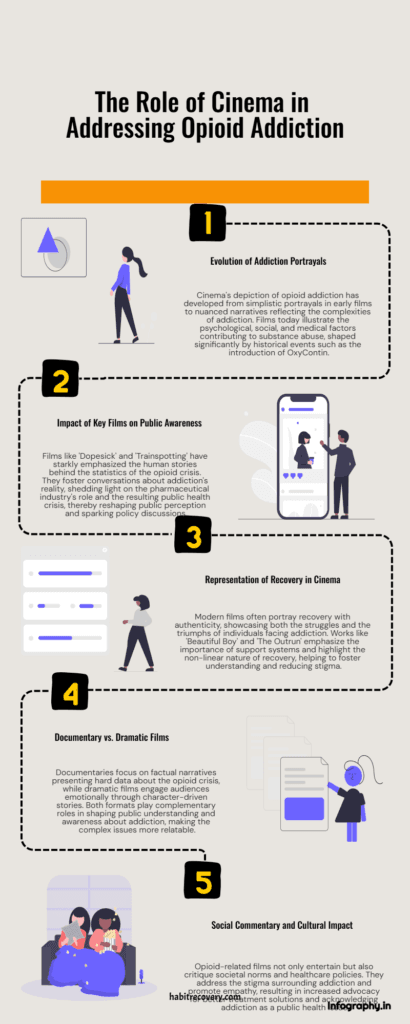“Trainspotting” opened my eyes to heroin addiction’s harsh reality. It wasn’t just a movie, but a window into an unfamiliar world. These films shape our understanding of the opioid crisis.
Film depictions of substance abuse have changed over time. Early silent films showed opium dens. Modern cinema now portrays prescription pill addiction with more nuance.
“Dopesick” highlighted the OxyContin epidemic and pharmaceutical companies’ role. It sparked important conversations about the opioid crisis. This series shows how storytelling can raise awareness and foster empathy.
The statistics are shocking. In 2019, over 20 million U.S. adults had substance use disorder. These numbers represent real people whose stories are told through cinema.

Key Takeaways
- Films like “Trainspotting” offer stark portrayals of drug addiction, providing insight into societal and psychological factors.
- “Beautiful Boy” and “Oxyana” tackle the narrative of the opioid crisis, focusing on prescription pill addiction.
- “Clean and Sober” and “28 Days” showcase the journey of overcoming addiction, emphasizing hope and support systems.
- Movies influence public perception, fostering empathy and understanding instead of judgment.
- Cinema’s power to evoke empathy is particularly significant in addiction narratives, offering personal connections to characters.
Understanding the Historical Context of Opioid Crisis in Cinema
Cinema’s view of the opioid crisis has changed a lot since the Civil War. Films now show addiction struggles differently. The way movies portray this issue reflects new social views and medical knowledge.
Evolution from Civil War Era to Modern Portrayals
Old films often showed opioid use too simply. Now, movies about the opioid epidemic are more complex. They look at many sides of addiction, including social factors and personal battles.
Impact of Historical Events on Drug Representation
Big events have changed how movies show addiction struggles. The 1990s release of OxyContin was a turning point. Films started to look at drug companies’ role in the crisis.
| Year | Event | Impact on Cinema |
|---|---|---|
| 1990s | OxyContin Introduction | Films explore pharmaceutical industry’s role |
| 2000-2014 | 200% increase in opioid overdoses | More realistic portrayals of addiction consequences |
| 2010-2014 | 3-fold increase in heroin overdoses | Focus on transition from prescription opioids to heroin |
Shifting Social Perspectives Through Decades
Movies have stopped stigmatizing addiction and now show its complexities. New films highlight the ‘disease of despair’ idea. They look at how people lose hope and social connections.
These movies stress the need for better public health approaches. They show how to address the opioid crisis more effectively.
“The opioid crisis is a disease of despair, alongside suicide and alcohol-induced liver disease. Cinema now reflects this complex reality.”
Cinematic Insights Movies Addressing Opioid Addiction: Analysis and Impact
Movies about addiction recovery are powerful tools for raising awareness and fostering empathy. They offer a raw look into the struggles of substance abuse. These films have become crucial in addressing the opioid crisis.
Classic films like “The Lost Weekend” and “Leaving Las Vegas” set the stage for modern portrayals. “Flight” earned nominations for its realistic depiction of an alcoholic pilot. These movies serve as both entertainment and educational resources.
“The Outrun” offers a nuanced portrayal of addiction and recovery. It follows a biology student’s non-linear journey through sobriety. The film highlights relapse risks and the loneliness often felt in early recovery.
It also explores how environment influences addiction and recovery. The movie contrasts chaotic city life with nature’s healing power.
“Recovery is rarely a straight path. It’s filled with ups and downs, challenges and triumphs.”
These films shape public understanding of addiction. They spark conversations about substance abuse and treatment options. They also highlight the need for comprehensive support systems.
By showing complex family dynamics, they provide a holistic view of recovery. This approach helps viewers grasp the full scope of addiction’s impact.
| Film | Year | Key Theme | Impact |
|---|---|---|---|
| Trainspotting | 1996 | Heroin addiction | Realistic portrayal of drug culture |
| Requiem for a Dream | 2000 | Multiple addictions | Visceral depiction of addiction’s consequences |
| The Outrun | 2023 | Recovery journey | Highlights nature’s role in healing |
These films don’t shy away from addiction’s harsh realities. Yet, they offer messages of hope. They show that recovery is possible, even in challenging situations.
This approach inspires individuals on their own recovery journeys. It also motivates those supporting loved ones through addiction.
Dopesick: A Landmark Series Exposing the OxyContin Epidemic
Dopesick offers a searing look at the OxyContin crisis. It explores the roots of America’s opioid epidemic. The series traces its origins to OxyContin’s 1996 introduction.
Michael Keaton’s Portrayal of Dr. Sam Finnix
Michael Keaton brings Dr. Sam Finnix to life. He shows the struggle of well-meaning doctors caught in the crossfire. By 2003, nearly half of OxyContin prescribers were primary care physicians.
The Sackler Family Dynamic
The series reveals the Sackler family’s role through Purdue Pharma. OxyContin generated about $35 billion in revenue. It also contributed to hundreds of thousands of addiction-related deaths.
Rural Community Impact Representation
Dopesick excels in showing the epidemic’s impact on rural communities. It depicts the spread from wealthy suburbs to distressed small towns. This mirrors real-life patterns of opioid abuse in Central Appalachia.
The series offers a critical look at healthcare and pharmaceutical marketing. It serves as both a warning and a call to action. Dopesick is a must-watch among addiction recovery films.
Documentary vs. Dramatic Portrayals in Addiction Films

Opioid crisis documentaries and dramatic films show substance abuse differently. Documentaries focus on facts and statistics. Dramatic films use personal stories to evoke emotions.
Documentaries raise awareness with data-driven narratives. They highlight the number of lives affected by addiction. This approach brings the crisis into sharp focus.
Dramatic movies offer a closer look at addiction’s human cost. They explore emotional journeys of individuals and families. These films make the crisis feel more personal and relatable.
Both styles shape public perception in unique ways. Documentaries inform viewers about the crisis. Dramatic films humanize the experience. Together, they create a full picture of the opioid crisis.
“Movies have the power to change hearts and minds. When it comes to addiction, both documentaries and dramas are essential in telling the full story.”
These films do more than entertain. They challenge stereotypes and promote dialogue. They can even influence policy decisions. As the crisis continues, cinema’s role grows more important.
Representation of Recovery and Treatment in Modern Cinema
Modern films now show drug addiction in a more complex way. They offer realistic portrayals of opioid addiction and recovery. These movies challenge stereotypes and reveal the intricacies of substance abuse.
Medical Treatment Portrayal
Movies now showcase various medical treatments for drug abuse. They highlight medication-assisted therapies for opioid addiction. This approach helps viewers learn about real-world treatment options.
Support Systems and Family Dynamics
Films like “Beautiful Boy” show how addiction affects family relationships. They depict the emotional struggles of those with substance abuse and their loved ones. These stories stress the importance of support systems in recovery.
Recovery Journey Narratives
TV series like “Euphoria” and “Elementary” authentically depict addiction recovery. They show the ongoing challenges individuals face on their sobriety journey. Films such as “Memory” (2023) and “Flight” (2012) reveal long-term effects of drug addiction.
These honest portrayals serve an educational purpose. They raise awareness, dispel myths, and build empathy for those battling substance use disorders. Modern cinema helps us better understand this complex issue through truthful storytelling.
Social Commentary and Cultural Impact of Opioid Movies

Opioid-themed films offer powerful social commentary on substance abuse. They highlight the opioid crisis and criticize healthcare systems and pharmaceutical companies. These movies help destigmatize addiction and promote empathy for those in recovery.
These films go beyond entertainment. They spark policy discussions and influence addiction treatment practices. Documentaries have highlighted shocking statistics about drug overdose deaths in the USA.
“Movies have the power to change hearts and minds. They’ve brought the opioid crisis out of the shadows and into our living rooms.”
Many films explore the link between opioid use and social isolation. They show how addiction affects individuals, families, and communities. This challenges societal norms and promotes better understanding of the opioid crisis.
The cultural impact is clear through increased awareness and action. High-profile opioid movies have led to more naloxone training programs. They’ve also influenced changes in opioid prescribing regulations.
These films have become catalysts for change. They’re reshaping our approach to substance abuse and addiction recovery. Their influence extends far beyond the silver screen.
Character Development in Addiction Narratives
Movies about opioid addiction showcase complex character journeys. These films depict the struggles of individuals battling substance abuse. They explore the psychological and physical effects, creating relatable and impactful stories.
Protagonist Journey Arcs
Main characters in addiction films face challenging paths. They confront drug use realities, encounter setbacks, and aim for recovery. “Trainspotting” and “Requiem for a Dream” vividly portray these struggles.
These narratives highlight the importance of mental health support. Addiction counseling plays a crucial role in recovery journeys.
Supporting Character Dynamics
Supporting characters enrich addiction narratives with diverse perspectives. Family, friends, and healthcare providers offer unique insights into the addiction experience. “Beautiful Boy” shows a father’s emotional turmoil dealing with his son’s addiction.
These portrayals emphasize the importance of support systems. Recovery networks are vital in overcoming substance abuse challenges.
| Film | Focus | Key Themes |
|---|---|---|
| Trainspotting | Addiction in Britain | Poverty, Drug Culture |
| Requiem for a Dream | Multiple Characters | Psychological Effects |
| Beautiful Boy | Family Impact | Parental Struggle |
| Euphoria | Teen Addiction | Self-harm, Trauma |
Character portrayals in addiction narratives deepen our understanding of the opioid crisis. These films show realistic journeys through addiction and recovery. They help reduce stigma and foster empathy for those affected by substance use disorders.
The Role of Healthcare Systems in Opioid Crisis Films
Movies about the opioid crisis often focus on healthcare systems. They reveal complex issues in addiction treatment and mental health support. In the U.S., where opioid abuse is widespread, films expose systemic problems.
“Dopesick” shows how healthcare providers got trapped in over-prescribing. Since OxyContin’s 1996 release, prescription rates soared. By 2012, there were enough opioid prescriptions for every adult American.
This led to a surge in addiction cases. Four out of five heroin users started with prescription opioids. Movies highlight the urgent need for better recovery support and rehab options.
Currently, 80% of people with opioid use disorders don’t get help. Films push for change in mental health and addiction treatment. They suggest cognitive behavioral therapy as a key strategy in fighting addiction.
